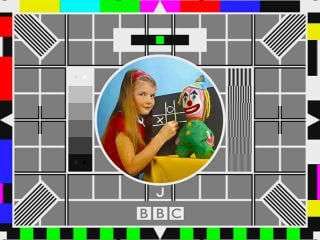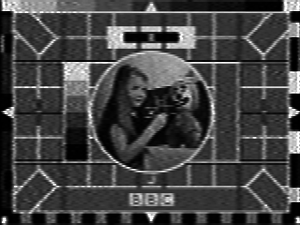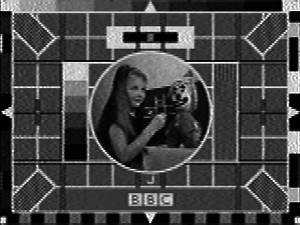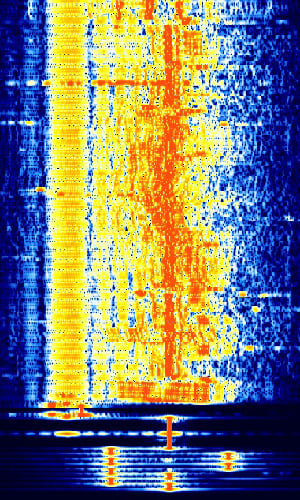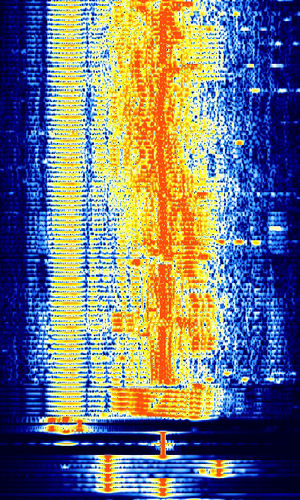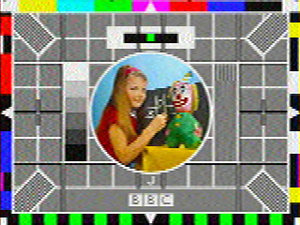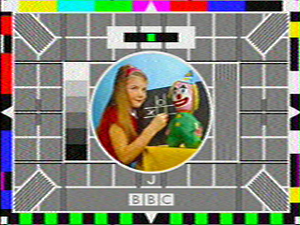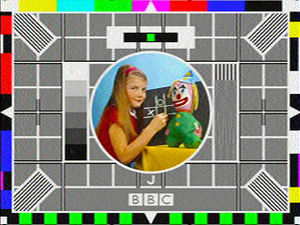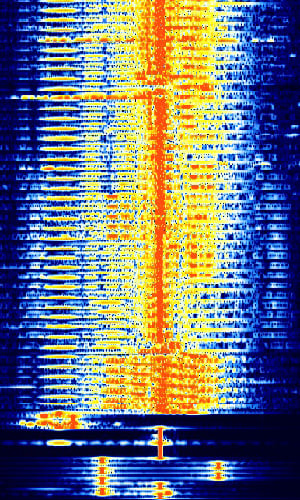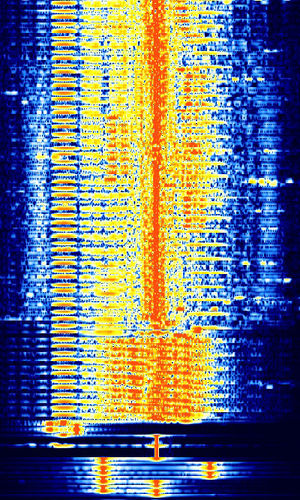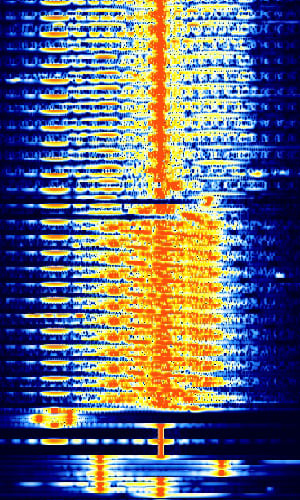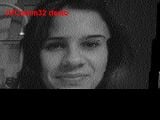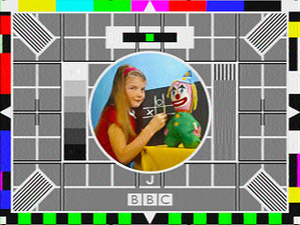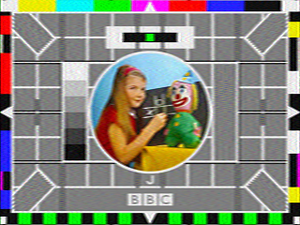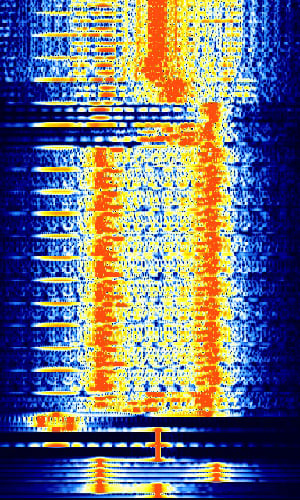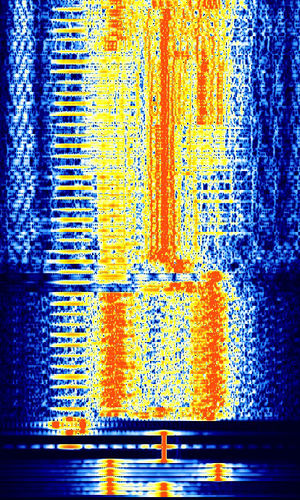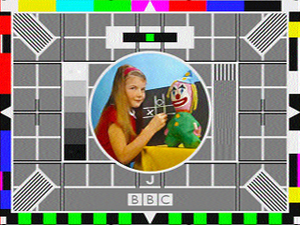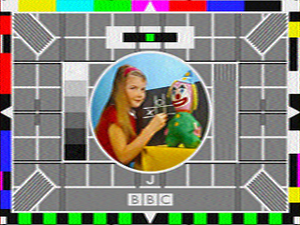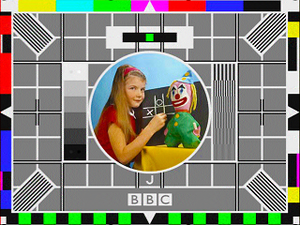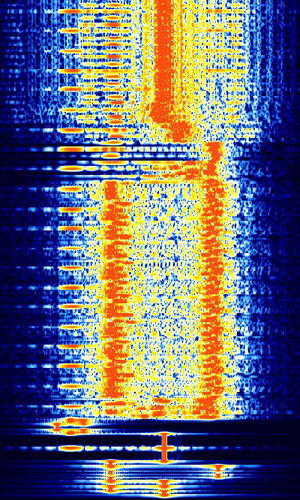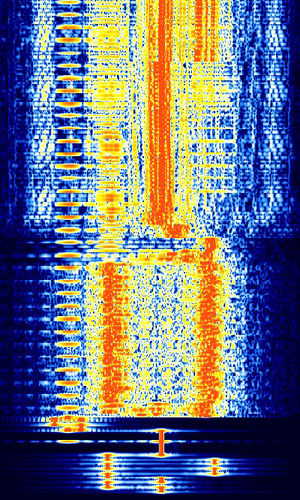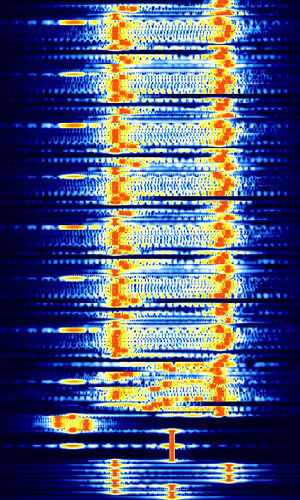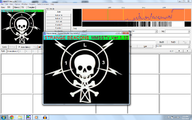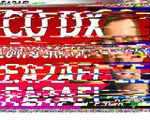Slow-Scan Television (SSTV)
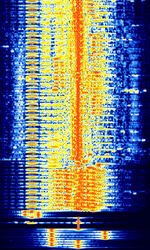 | |
|---|---|
| Frequencies | 3 MHz,450 MHz |
| Frequency Range | 3 MHz - 450 MHz |
| Mode | USB, LSB, NFM |
| Modulation | FM |
| ACF | Line per minute. |
| Emission Designator | — |
| Bandwidth | 3 kHz |
| Location | Worldwide |
| Short Description | Slow-scan television (SSTV) is a method for picture transmission used by amateur radio operators to transmit and receive images. |
| I/Q Raw Recording | Download file |
| Audio Sample | |
Slow-scan television (SSTV) is a method for picture transmission used by amateur radio operators to transmit and receive images. A technical term for SSTV is narrowband television. The most popular modes of SSTV are Robot, Scottie, and Martin.
Commercial analog television signals require 6 to 8 MHzMegaHertz (MHz) 10^6 Hz of bandwidth, because it transmits 25 or 30 picture frames per second (in the NTSC, PAL or SECAM color systems), but SSTV usually only takes up a maximum of 3 kHzKiloHertz (kHz) 10^3 Hz of bandwidth. It is a much slower method of still picture transmission, usually taking from about eight seconds to a couple of minutes, depending on the mode used, to transmit one image frame.
SSTV uses analog frequency modulation, in which every different value of brightness in the image gets a different audio frequency. In other words, the signal frequency shifts up to create brighter pixels and shifts down to create darker pixels. Color is achieved by sending the brightness of each color component (usually red, green and blue) separately.
Sync is 1100 to 1300 HzHertz (Hz), unit of frequency, defined as one cycle per second (1 Hz).; channel information is 1500 to 2300 HzHertz (Hz), unit of frequency, defined as one cycle per second (1 Hz)..
SSTV has been used in popular culture, including secret easter eggs in the video games Portal and Portal 2 by Valve. It was also used in the famous entertainment site Newgrounds, for their opensource video game Friday Night Funkin. << The mode used for the resulting image was Scottie 2, and decodes to a note made by the author about how the internet has evolved along with its culture, how it was formed, etc.
The reddit article to prove this image here: https://www.reddit.com/r/FridayNightFunkin/comments/kk9j1v/the_possible_friday_night_funkin_arg/
Modes[edit]
Original Image:
Robot[edit]
Description[edit]
SSTV Robot was developed by Robot Research Corporation. Used to send images over HFHigh Frequency (3-30 MHz) and VHFVery High Frequency (30-300 MHz) frequencies. The most popular modes in use today are Robot 36 and Robot 72.
Samples[edit]
| Robot 8 B/W | Robot 12 B/W | |
|---|---|---|
| Sample | ||
| Waterfall |
| Robot 24 | Robot 36 | Robot 72 | |
|---|---|---|---|
| Sample | |||
| Waterfall |
Additional Images[edit]
Martin[edit]
Description[edit]
SSTV Martin was developed by Martin Emmerson, and was originally included as a ROM enhancement for Robot Research's SSTV units. Martin mode scans 256 lines instead of the standard 240. This is usually to give HAM operators 16px of banner room above or below their image for their callsign and other text. Martin is primarily used in Europe.
Samples[edit]
| Martin 1 | Martin 2 | |
|---|---|---|
| Sample | ||
| Waterfall |
Additional Images[edit]
Scottie[edit]
Description[edit]
SSTV Scottie was developed by Eddie Murphy GM3BSC, and was originally included as a ROM enhancement for Robot Research's SSTV units. Scottie mode scans 256 lines instead of the standard 240. This is usually to give HAM operators 16px of banner room above or below their image for their callsign and other text.
Samples[edit]
| Scottie 1 | Scottie 2 | ScottieDX | |
|---|---|---|---|
| Sample | |||
| Waterfall |
Additional Images[edit]
|
|
Decoding Software[edit]
- Android Apps
- Black Cat Software
- Black Cat SSTV Windows, MAC OS
- Black Cat SSTV app for IPhone, IPad, ITouch
- MultiMode Cocoa
- Linux
- Mac OS
- Windows
- ChromaPix downloads and others
- EasyPal
- Hoka Code 300-32
- JVComm32
- MixW
- MM-SSTV
- MultiPSK
- RadioCom 6
- RX-SSTV
- Sorcerer
- W-Code
- W-Spectra
- Professional Equipment/Software
Encoding Software[edit]
- SSTV Encoder (Android)
SSTV frequencies[edit]
- HFHigh Frequency (3-30 MHz) Bands
| Band | Freq. (kHzKiloHertz (kHz) 10^3 Hz) | Mode | Notes |
|---|---|---|---|
| 160m | 1890 | LSBLower Side Band Modulation | |
| 80m | 3730 | LSBLower Side Band Modulation | Europe |
| 80m | 3845 | LSBLower Side Band Modulation | |
| 6925 | USBUpper Side Band Modulation (Radio, referring to reception and modulation mode)Universal Serial Bus (Computer, referring to USB Ports and cables) | Pirate Transmissions | |
| 40m | 7165 | LSBLower Side Band Modulation | Europe |
| 40m | 7171 | LSBLower Side Band Modulation | |
| 40m | 7180 | LSBLower Side Band Modulation | Proposed |
| 30m | 10132 | USBUpper Side Band Modulation (Radio, referring to reception and modulation mode)Universal Serial Bus (Computer, referring to USB Ports and cables) | MP73N Mode Only |
| 20m | 14230 | USBUpper Side Band Modulation (Radio, referring to reception and modulation mode)Universal Serial Bus (Computer, referring to USB Ports and cables) | Alternates: 14227 kHzKiloHertz (kHz) 10^3 Hz USBUpper Side Band Modulation (Radio, referring to reception and modulation mode)Universal Serial Bus (Computer, referring to USB Ports and cables) 14233 kHzKiloHertz (kHz) 10^3 Hz USBUpper Side Band Modulation (Radio, referring to reception and modulation mode)Universal Serial Bus (Computer, referring to USB Ports and cables) |
| 15m | 21340 | USBUpper Side Band Modulation (Radio, referring to reception and modulation mode)Universal Serial Bus (Computer, referring to USB Ports and cables) | |
| 27700 | USBUpper Side Band Modulation (Radio, referring to reception and modulation mode)Universal Serial Bus (Computer, referring to USB Ports and cables) | Pirate Transmissions | |
| 10m | 28680 | USBUpper Side Band Modulation (Radio, referring to reception and modulation mode)Universal Serial Bus (Computer, referring to USB Ports and cables) |
Adapted from Wikipedia
- VHFVery High Frequency (30-300 MHz)/UHFUltra High Frequency (300-3000 MHz) Bands
| Band | Freq. (MHzMegaHertz (MHz) 10^6 Hz) | Mode | Notes |
|---|---|---|---|
| 6m | 50.680 | NFMNarrowband Frequency Modulation | |
| 6m | 50.950 | USBUpper Side Band Modulation (Radio, referring to reception and modulation mode)Universal Serial Bus (Computer, referring to USB Ports and cables) | |
| 2m | 145.500 | NFMNarrowband Frequency Modulation | |
| 2m | 145.550 | USBUpper Side Band Modulation (Radio, referring to reception and modulation mode)Universal Serial Bus (Computer, referring to USB Ports and cables) | |
| 2m | 145.600 | NFMNarrowband Frequency Modulation | |
| 2m | 145.625 | NFMNarrowband Frequency Modulation | Australia |
| 2m | 145.800 | NFMNarrowband Frequency Modulation | ISSInformation Sending Station in an ARQ link (The station sending information to the recipient). Usually the signal that's longer in duration than the short RQ (Repeat Request) bursts from the IRS. Downlink Call: RS0ISS |
| 1.25m | 223.850 | NFMNarrowband Frequency Modulation | |
| 70cm | 433.775 | NFMNarrowband Frequency Modulation USBUpper Side Band Modulation (Radio, referring to reception and modulation mode)Universal Serial Bus (Computer, referring to USB Ports and cables) |
Australia |
| 70cm | 430.950 | NFMNarrowband Frequency Modulation USBUpper Side Band Modulation (Radio, referring to reception and modulation mode)Universal Serial Bus (Computer, referring to USB Ports and cables) |
Video Examples[edit]
- SSTV Transmission & Decode
- Portal Update 3/1/2010 (transmission received) SSTV and CW Morse Code
- SSTV decoding via smartphone app next to radio
